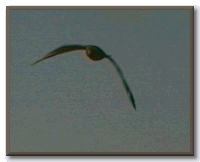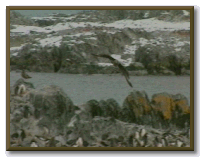Most Antarctic bird species breed annually and lay a single egg which is very much larger in relation to their body weight than most other birds. King Penguins and some albatrosses breed less frequently and have the lowest reproductive rate of any birds.
The remaining groups of birds feed close to land or on marine organisms scavenged along the shore. Two species of Cormorants (order Pelecaniformes), Blue-eyed Shag and Kerguelen Shag, are fish-eating birds that pursue their prey underwater. They are not strong flyers and mostly stay close to shore. The chicks, usually 2-4 in number, are naked when newly hatched and are carefully brooded until the dark down appears. The Gulls, Terns, Skuas and Sheathbills all belong to the order, Charadriiformes.
|
|
|
The South Polar Skua breeds all around the Antarctic continent and its more northern counterpart, the Brown Skua, on sub-Antarctic islands. Both feed on marine life and also on carrion, when available. The Dominican Gull and the Antarctic Tern breed along the coast or on the offshore islands at the northern end of the Antarctic Peninsula, and the sub-Antarctic islands. All these species feed around the shores in summer, but most range widely during the winter. The Arctic Tern migrates annually to the Antarctic.
The Sheathbills, however, remain mostly on land during the austral winter. These curious all-white birds, although, unrelated, bear a superficial resemblance to pigeons, both walking and when in flight. Their feet, unlike other Antarctic sea birds, have only rudimentary webs. They are mostly scavengers along the shore line feeding on marine organisms and carrion. They also prey on penguins by taking eggs and small chicks.
|
|
WANT TO LEARN MORE?
|
|
|
Websites
• Antarctic petrel Information including taxonomy of the Antarctic petrel. • South polar skua Information on the South polar skua includes taxonomy information. • Southern giant-petrel Facts about the Southern giant-petrel including taxonomy. • Prehistory More background information on the prehistory of Antarctica. • Antarctic Adventure 1997 Information on the geography and climate of Antarctica. |
|
![]()

